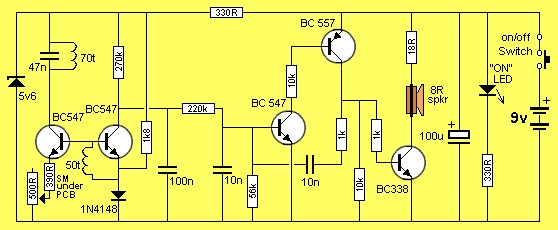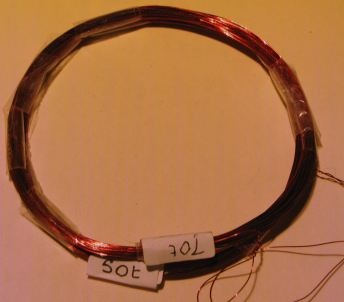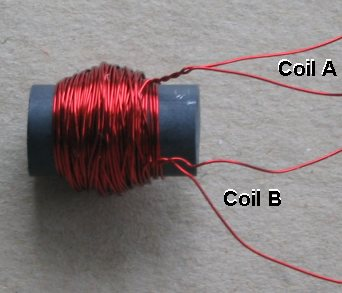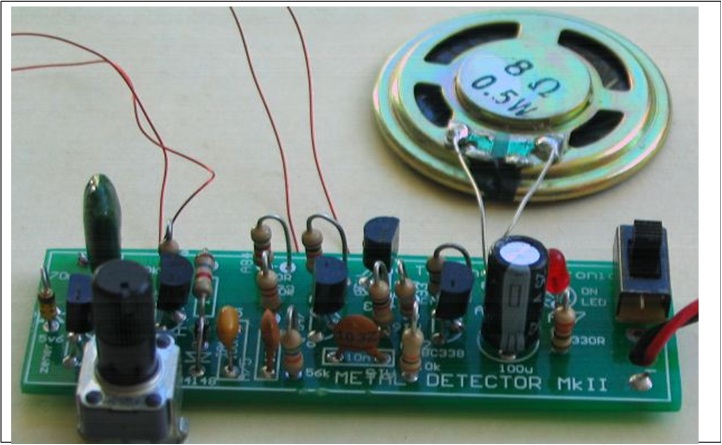This Metal detectors will detect ferrous (iron, steel, stainless steel) as well as non-ferrous (copper, tin, gold, lead, silver, aluminium) as well as alloys (brass, cupro-nickel, pewter etc).
Depending on the complexity of the circuit, a metal detector will be able to discriminate between a lump of gold and an aluminium ring-pull from a drink-can.
The circuit we have presented in this project is very simple and works on the principle of detecting the amplitude of a waveform. This is called AMPLITUDE MODULATION.
When a metal object is placed inside the detecting coil, some of the magnetic flux passes into the object and creates a current called an eddy-current. This “uses-up” some of the magnetic flux and thus less flux is available for the receiving coil.

This produces a lower output from the “receiving coil” and causes the second transistor in the circuit to be turned OFF slightly and the voltage on the collector rises. This allows the third and fourth transistors to oscillate and pass a signal to the fifth transistor to drive a mini speaker.
1. The first block is a FEEDBACK OSCILLATOR, consisting of the first transistor, 70 turn coil, 47n and the 50 turn coil. The first transistor is turned on via the diode in the emitter of the second transistor. This diode receives its turn-on bias from the 1k8 resistor.

The resistance of the receiving coil is very small and the base of the first transistor sees a “turn-on” voltage from the voltage across the diode.
The variable resistor in the emitter starts at a low value for our description of the circuit.
The first transistor has a high gain at this point in time and the transmitting coil and 47n form a tuned circuit with a frequency of approx 15kHz.
The power rail is stabilized by the 5v6 zener and a small amount of noise is always present in any circuit and causes a small waveform to be produced by the coil and capacitor.
This waveform is passed to the receiving coil (through the air) and a small voltage is produced across it.
Since the end of the receiving coil connected to the diode, it is fixed and rigid and the signal produced by the coil is passed to the base of both transistors. The coil is connected so the voltage it produces turns the first transistor ON harder and thus the waveform produced by the tuned circuit is increased.
Since the resistance of the pot is a minimum, the amplitude of the waveform will be a maximum and this will have the effect of turning ON the second transistor so the voltage on the collector will be very low. The signal on the collector will be a waveform but this is smoothed by the 100n capacitor.
As the resistance of the pot is increased, the voltage on the emitter will increase and the base-to-emitter voltage will be LESS, so the transistor will not be turned on as much. The waveform produced by the tuned circuit will reduce.
This will be reflected in the receiving coil and the second transistor will also get turned off slightly. The voltage on the collector will rise and this will be passed to the second building block.
2. THE VOLTAGE CONTROLLED OSCILLATOR transistors 3 and 4.
The voltage controlled oscillator is simply a direct-coupled high-gain amplifier with a 10n feedback capacitor to provide oscillation.
When a voltage appears on the base of the third transistor, it turns ON and this turns on the PNP transistor.
The voltage on the collector of the PNP transistor rises and this pulls one end of the 10n capacitor (via a 1k resistor) towards the positive rail.
The other end of the capacitor is connected to the base of the third transistor. This turns ON the third transistor.
They keep turning ON until both are fully saturated (turned on). This happens very quickly and during this time the 10n capacitor starts to charge. The charging current flows through the base-emitter junction of the third transistor and as the capacitor charges, it develops a voltage across it. This causes the charging current to reduce. The third transistor gradually turns off and this turns the fourth transistor off slightly. The voltage on the collector of the fourth transistor drops and the voltage across the 10n capacitor causes the third transistor to turn off completely. This turns off the fourth transistor and now both are fully turned off.
The 10n discharges through the 56k and the cycle repeats. The capacitor takes a very short time to charge and a longer time to discharge. This is why the output consists of very short spikes.
Now we come to the reason why the frequency alters.
As the voltage from the previous building block rises, the charge-time for the first 10n capacitor is less and thus the first transistor in the oscillator circuit is turned on in a shorter period of time. This capacitor is discharged when the two transistors are turned off and the lead of the second 10n is taken to near the 0v rail by the 1k resistor in series with another 1k resistor and the base of the driver transistor. It’s fairly complex and if you have a CRO, you will notice the waveforms on the 10n capacitors go below the 0v rail.
This is how the two-transistor direct-coupled amplifier turns into a variable-frequency oscillator.
3. THE DRIVER TRANSISTOR. The output of the oscillator is connected to a driver transistor via a 1k resistor. This resistor prevents high currents flowing when both transistors are turned on. The driver transistor is directly connected to an 8 ohm speaker. The 18R resistor reduces the volume and prevents large spikes appearing on the power rails. The result is a clicking sound.
For this type of circuit to be successful, the supply voltage must be maintained absolutely rigid for the detecting section. This is very difficult to do as the battery voltage changes as it gets older and all the semiconductor devices change according to the temperature. The supply voltage must be as stable as possible as the circuit is detecting a very small change in amplitude and the supply voltage has an effect on the size of the signal. The circuit uses a zener diode to create a fixed supply but as the temperature of the diode heats-up with current-flow, the circuit-settings change and a tone is gradually produced by the speaker. This has to be stopped by adjusting the pot on the emitter of the first transistor. This constant resetting of the circuit is called INSTABILITY and is one of the downfalls of the design.
However, for a simple circuit it offers very good sensitivity and an audio output.

Metal detector circuits are a very big part of industry, not only to detect metal particles in food but also hidden objects on persons entering various venues.
They are also used to detect the difference between iron compounds and gold – such as the latest gold detectors.
They are also used to detect coins for vending machines and in this instance they are generally called “coin comparators.” Metal detection is a very big field, from detecting old nails in second-hand timber to mine sweeping via helicopters.
THE COILS

Wind the 50 turn and 70 turn coil on a tin or glass jar and add a pencil that can be removed so the winding can be easily removed.
The transmitting (oscillating) coil is 70 turns and the detecting coil is 50 turns.
The two coils must be placed together and covered with tape to keep them together.
Make sure the 70t coil is connected across the 47n capacitor as the circuit will not work if the coils are exchanged. Don’t worry about the correct connection of the second coil as it can be turned over if the circuit does not work.
The circuit will detect a small button cell about 7cm above the coil.
SETTING-UP
Keep the two coils slightly apart and set the 500R pot to mid-position. The output will produce a tone.
Slide the coils slightly closer together and turn the pot to stop the tone. If the tone does not stop, turn one of the coils over.
If the pot has no range, remove one turn of the 50 turn coil. Keep doing this until the two coils are touching and the pot is at mid-range. Tape the two coils together.
Adjust the pot until you get a very low-frequency clicking noise. This is the most sensitivity setting.
NAIL FINDER
This project can also be used to find tiny components such as nails and lost components.
This is an essential tool for servicemen and anyone trying to find a metal object hidden or buried in timber, soil or mud. It uses a “head” that is wound on a 10mm ferrite rod, consisting of 70 turns and 50 turns – the same number of turns as the air-wound coils. It is connected just like the air coils.
Metal Detector Part List
1 – 18R resistor all 0.25 watt
2 – 330R
1 – 390R
2 – 1k
1 – 1k8
2 – 10k
1 – 56k
1 – 220k
1 – 270k
1 – 500R mini pot
2 – 10n ceramics
1 – 47n ceramic or poly
1 – 100n ceramic
1 – 100u electrolytic
1 – 30metre 0.25mm enamelled winding wire
1 – 10mm ferrite rod 20mm long
1 – 1N 4148 signal diode
1 – 5v6 zener diode
1 – 3mm red LED
3 – BC 547 transistors
1 – BC 557 transistor
1 – BC 338 transistor
1 – 8R mini speaker
1 – 9v battery snap
1 – 9v battery (not in kit)
1 – 30cm very fine solder
1 – Metal Detector MkII PCB







